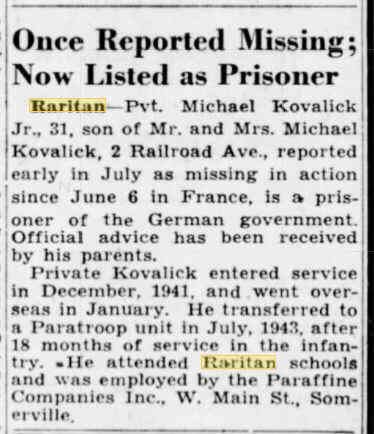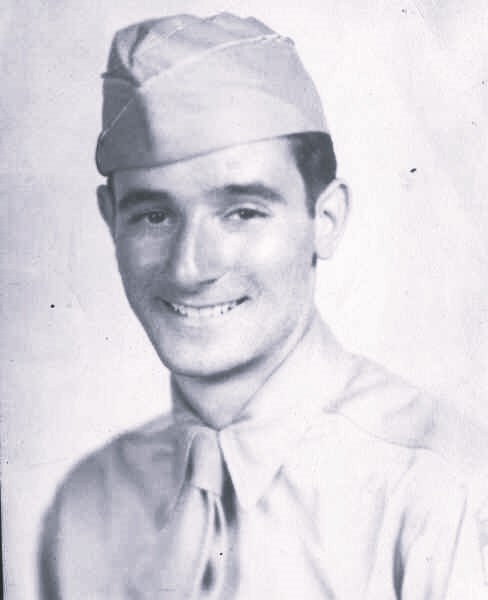The Allied Invasion of Europe During World War II
By Bruce Doorly
June 6th 1944, was one of the most significant days during World War II - both on the Battlefront and the Homefront.

The Germans had taken over France, Poland, Austria, Czechoslovakia, Norway, Denmark, Netherlands, Luxembourg, and Belgium. The Allies were gearing up for a massive invasion of Europe in order to finish off the Germans. In Southeastern England troops, ships, and equipment were being amassed in numbers never seen before.

The pending invasion was so well known that the usual censorship applied to letters written home by soldiers was relaxed.
Frank Zanetti of 45 Gaston Avenue in Raritan would write home to Raritan Tavern Owner Tony Orlando - stating
“As you know by reading the papers, that the biggest show on earth will take place in the near future. I expect to be in that show.”

The shortest distance from England to the coast of France is 20 miles to the area called the Pas-de-Calais. All the Allies' deceptions pointed to their landing there. Yet they planned to land at a more southern location – Normandy, France
 |
Preparations for the invasion began weeks before with intense Allied aerial bombing over a wide range of coastal locations in France.
Then on invasion day (June 6th, 1944), just after midnight, hours before the troops were scheduled to land on the beaches, 15,000 paratroopers were dropped by air over various positions just outside of the Normandy coast. Their objective was to secure some key bridges while destroying other bridges. But most paratroopers landed off course or were too scattered to mount any military operation. Many were killed or captured.
One paratrooper, Michael Kovalick from 2 Railroad Avenue in Raritan, was captured by the Germans. He would later escape.
While a few key bridges were secured by the paratroopers, their main benefit to the battle happened by accident as their scattering confused the Germans as to where the invasion was.
These articles are all we know about Michael Kovalick

The Allies had divided up their landings at the Normandy beaches into five areas that they gave names of Omaha, Utah, Sword, Gold, and Juno. The Americans would invade Omaha and Utah, the British would take Sword and Gold, and the Canadians would handle Juno.
The first day of the invasion consisted of the landing of 170,000 troops, with support from 4500 ships. In addition, at least 20,000 vehicles would be moved onto land as well. It was by far the largest military invasion in history.
Unfortunately, the coastal defenses for the Germans were the largest defensive buildup in history with many concrete bunkers containing machine guns that could fire 20 rounds per second.

Bridgewater’s Charles Foggiano’s unit landed early on Omaha beach. He described their trek across the beach as a “turkey shoot” and they were the turkeys. Over half his unit were casualties. It would take hours for the Americans to take over Omaha Beach. The determination and bravery of the troops, combined with naval bombardment eventually led to the Americans taking the beach area.
A week later, for heroics at the battle at St Lo,
Charles would be awarded the Silver Star.
of the battle at Omaha beach. Click on link.

At the time of the battle this did not phase Gabriel as he had a job to do. However, years later these images would come to haunt him. (Gabriel Frangione served as the Grand Marshal of the Basilone Parade in 2010.)
Click for bio and photo
By the end of D-Day the beachheads were in Allied hands.
It is estimated that 4200 Allied men were killed on D-Day. Another 6000 were injured.
The Allies had established a foothold and were now able to move toward Germany.

The American public was first alerted of the invasion at 12:30 AM Eastern time. That is when a live broadcast of the Harry James Orchestra was interrupted with a short announcement that “Radio Berlin” had stated that the invasion had started. The public was cautioned that this, for now, was only the enemy’s announcement.
It was not until 3:33 AM (9:33 AM in France) that the Allied Headquarters made the official announcement that the invasion had begun.
Family and friends joined together and packed the churches to pray for the safety of their loved ones. It was announced that President Franklin Roosevelt would lead the public in prayer that evening.

The start has been made. Berlin is the goal but it is still far away. We must be patient and have confidence in the judgement of Allied commanders. We have been warned the price of victory will be great.
It would take eleven more months until Germany surrendered on May 8th 1945.
So, this June 6th take a moment out to reflect on the sacrifice that was made 80 years ago.
Sadly 99% of World War II veterans have passed on.